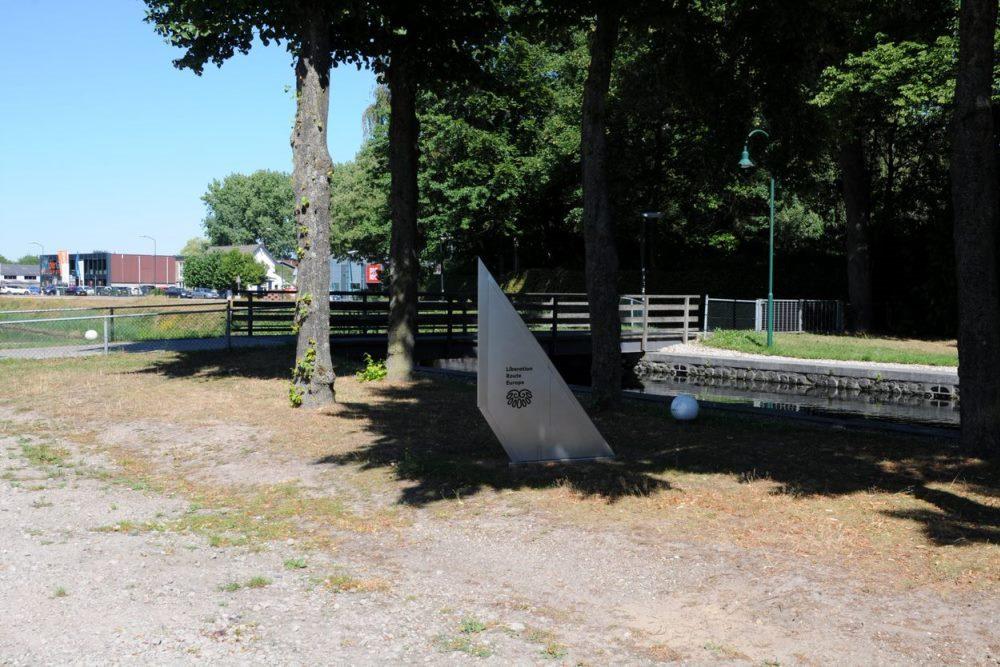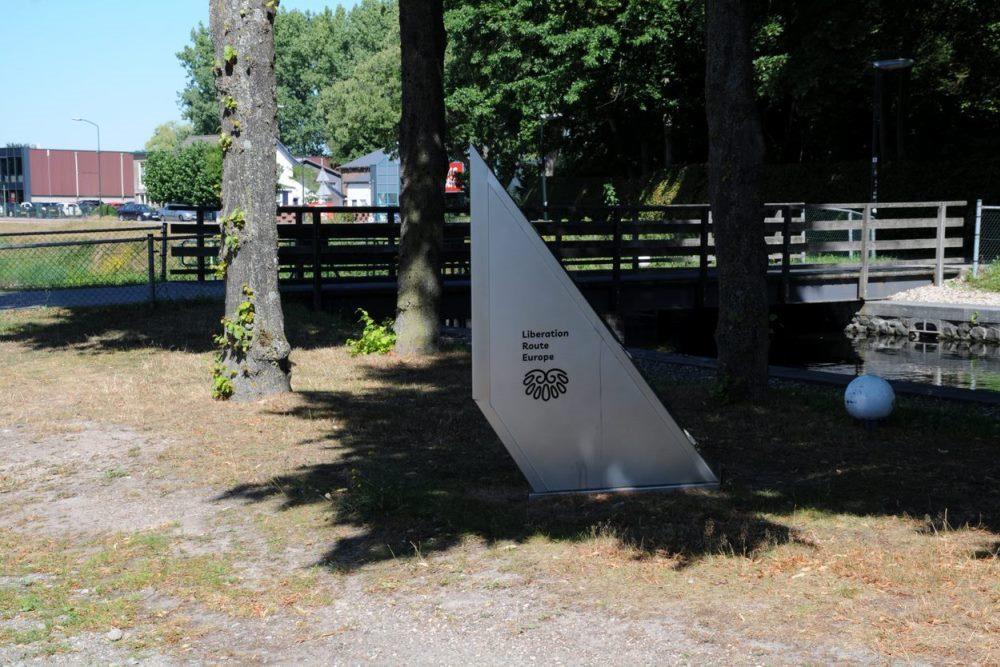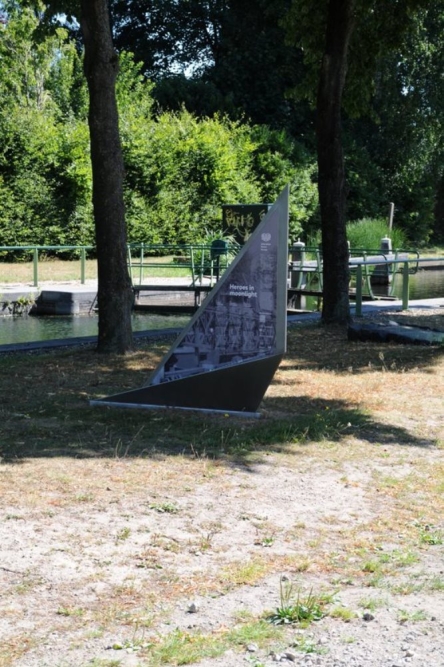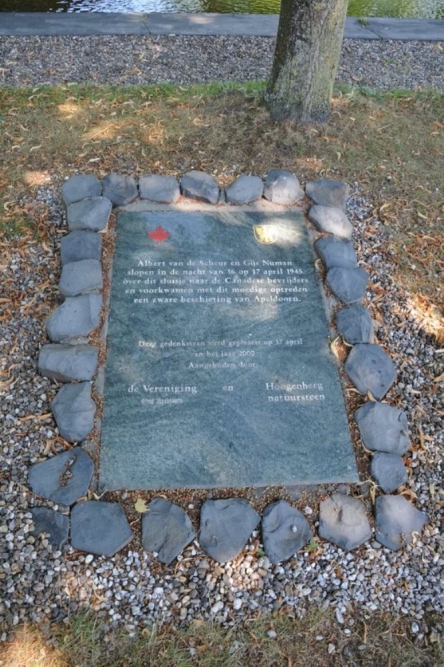Vector of Memory: Heroes in Moonlight
Heroes by moonlight
This is where the liberation of Apeldoorn started - here, on the night of the 16th of April 1945. Albert van de Scheur and Gijs Numan crept across this very lock towards the Canadian liberators, knowing just how to stop them from blowing Apeldoorn to pieces. This heroic act saved Apeldoorn from heavy artillery fire just before the decisive attack on the Apeldoorn canal.
On Friday 13th April 1945, the Canadian advance to Apeldoorn came to a standstill. The Broeksbrug bridge over the Apeldoorn canal had been blown up by the Germans and the Canadian's attempt to secure the Deventerbrug bridge had failed. The Canadians were expecting Apeldoorn to be strongly defended by the Germans and planned to attack the Deventerbrug bridge, starting with heavy artillery fire. Gijs Numan, commander of the Dutch Interior Forces in Apeldoorn knew about the Canadian's plans and knew that they would need to seize the bridge in one piece. He went to the bridge and convinced the Germans that were protecting it to hand themselves over.
On the night of the 16th April, Gijs Numan crossed the canal with a guide to report to the Canadians, but the commanding officer did not believe the Germans had left. There was no chance of them changing their plans. Gijs Numan offered to bring the German prisoners to the commanding officer for interrogation. This, he did, and the Canadians finally decided not to open fire on the bridge or on Apeldoorn. They decided to attack at night instead, and they secured the bridge and the surrounding area without any resistance from the Germans. At 9:00 hours on 17th April 1945, the first troops arrived at the royal palace, Palace Het Loo in Apeldoorn and later that day, the rest of the town was liberated.
Audiospot - Heroes by moonlight
Liberation Route Europe is a certified Cultural Route of the Council of Europe. With hundreds of sites and stories in nine European countries, the route links the main regions along the advance of the Allied Forces in 1943-1945.
The entire route consists of themed routes that can be travelled by by hiking, walking, cycling and car. These routes pass numerous historical and interesting sites and tell stories from a multitude of perspectives that were important in the final phase of World War II.
A separate group within the routes are the Vectors of Memory designed by renowned architect Daniel Libeskind. They form a symbolic family of landmarks that honor people, places and stories in the European landscape. The vectors are a topography of memory. They act as points in both space and time and connect to the liberation story. It is important that the markers convey a clear and powerful message.
There are 4 types of vectors:
- The Remembrance Site Vector
- The Crossroads Vector
- The Wall Vector
- The Floor Vector
For more information on the Vectors of Memory see the Liberation Route Europe site: https://www.lre-foundation.org/vectors-of-memory/.
The routes can be found on the website of Liberation Route Europe or in the app through which many stories can also be listened to.
The routes can be found on the Liberation Route Europe website or in the app through which many stories can also be listened to.
Do you have more information about this location? Inform us!
Source
- Text: TracesOfWar & Liberation Route Europe
- Photos: Henri Verhaaf
Nearby
Museum
- Apeldoornsche Bosch Remembrance Centre - Apeldoorn
- Museum of the Chancellery of Dutch Orders - Apeldoorn
- Collection '40-'45 - Beekbergen
Point of interest
- NSB Office Ancestry Research - Apeldoorn
- Former Villa & Bunker Arthur Seyss-Inquart - Apeldoorn
- Villa 'Laag Buurlo' - Apeldoorn
Monument
- Memorial 'Stones in the resistance fighters park' - Apeldoorn
- Memorial 'Het Apeldoornsche Bosch' - Apeldoorn
- Memorial Resistance Apeldoorn - Apeldoorn
Cemetery
- Dutch War Graves Wenum - Wenum
- Dutch War Graves General Cemetery Heidehof Ugchelen - Ugchelen (Apeldoorn)
- Commonwealth War Graves Cemetery Heidehof Ugchelen - Ugchelen (Apeldoorn)
Remembrance Stone
- Remembrance Stones Tutein Noltheniuslaan 52 - Apeldoorn
- Memorial Stone Burgemeester Tutein Noltheniuslaan 50 - Apeldoorn
- Remembrance Stones Tutein Noltheniuslaan 27 - Apeldoorn








